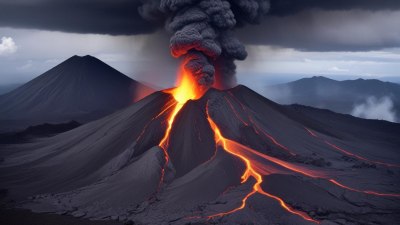Why Cold Air Falls and Warm Air Rises: The Basics of Weather
Discover the fundamental principles of weather, explaining why cold air sinks and warm air rises.

The basic principles of weather are rooted in the behavior of air masses and their varying temperatures. Understanding why cold air falls and warm air rises is crucial for grasping the complexities of meteorology. Air is composed of molecules that move in response to temperature changes. When we heat air, the molecules gain energy and move faster, causing the air to expand and become less dense. Conversely, when the air cools, the molecules lose energy, move slower, and the air becomes denser.
This difference in density is the key reason for the behavior of warm and cold air. Warm air is lighter than cold air, which causes it to rise. As it rises, it expands and cools. This process is known as convection and is one of the primary mechanisms through which heat is distributed in the atmosphere. The rising of warm air creates a low-pressure area at the surface, which can lead to the movement of air from surrounding areas, contributing to wind and weather patterns.
The Science of Air Density
Air density is affected by temperature, pressure, and humidity. As air warms, its density decreases. This is why in a controlled environment such as a weather balloon, once the air inside the balloon heats up, it will rise due to being lighter than the surrounding cooler air. The opposite occurs with cold air. Cold air, being denser, tends to accumulate in low-lying areas and sinks down. This principle explains a variety of weather phenomena, including temperature inversions, fog, and even precipitation patterns.
Convection Currents
Convection currents are loops of moving air created by the unequal heating of the Earth's surface. During the day, land heats up faster than water, causing the warm air above the land to rise. As the warm air rises, cooler air from over the water moves in to replace it, creating a breeze. This same principle applies on a larger scale, influencing wind patterns around the globe. Convection also plays a role in the formation of clouds and storms. When warm air rises, it cools, and moisture within it condenses to form clouds. If enough warm, moist air rises rapidly, it can lead to storm systems and severe weather.
Effects of Earth's Rotation
The Coriolis effect, caused by the Earth's rotation, influences wind patterns and helps distribute air heat around the planet. As air moves towards the equator from the poles, it is deflected due to the rotation of the Earth. This deflection affects large weather systems, contributing to the formation of trade winds, westerlies, and polar easterlies. Furthermore, the combination of the Earth's tilt and rotation creates seasonal changes in weather. During summer months, warm air rises more prominently, affecting local and global weather patterns.
Temperature Inversions
A temperature inversion occurs when a layer of warm air traps cooler air near the surface. This can lead to fog and poor air quality as pollutants are trapped below the inversion layer. Understanding temperature inversions is essential for meteorologists as they can significantly affect local weather and climate conditions. These inversions usually occur at night, when the Earth's surface cools more quickly than the higher atmosphere, leading to a warm air cap. The effects of inversions range from creating clear skies with cooler air to causing smog in urban areas.
Weather Fronts
Weather fronts occur when different air masses collide, leading to significant weather changes. A cold front occurs when a cold air mass pushes into a warmer air mass, causing the warm air to rise rapidly, often resulting in thunderstorms and severe weather. Conversely, a warm front occurs when warm air overtakes cold air, leading to gradual lifting of the air and the formation of clouds and rain. Understanding how these fronts interact with the principles of rising and sinking air is key to predicting weather events.
Humidity and Its Effects
Humidity plays a crucial role in the behavior of air masses. When air is humid, it contains water vapor, which is less dense than the surrounding air. This makes humid air more buoyant than dry air, causing it to rise more easily. The presence of moisture also influences the cooling of rising air, as the moisture condenses at higher altitudes, releasing latent heat which can further fuel convection processes. Meteorologists often monitor humidity levels to predict storms, as high humidity is often associated with severe weather patterns.
Global Wind Patterns
Global wind patterns are influenced by convection and the Earth's rotation, leading to the distribution of heat around the planet. The Hadley, Ferrel, and Polar cells describe the major circulatory patterns that dominate the Earth's atmosphere. These cells are responsible for trade winds, westerlies, and polar easterlies, respectively. Understanding these patterns can help explain long-term weather trends, as shifts in these global flows can lead to changes in climate and weather extremes.
The Role of the Sun
The sun is the primary source of energy for Earth's weather systems. Solar radiation heats the Earth's surface unevenly due to factors like geography, topography, and land use. This uneven heating leads to temperature variations that drive wind patterns and the movement of air masses. The sun also influences the water cycle, affecting evaporation and precipitation, which are essential components of the weather. Without the sun's energy, the processes responsible for air rising and sinking would not occur.
In conclusion, the processes of cold air sinking and warm air rising are foundational to our understanding of weather. They are driven by the principles of density, convection, the Earth's rotation, and the sun's energy. By grasping these basic concepts, we can better understand how weather systems form, interact, and evolve. This knowledge is not just relevant for meteorologists but is essential for anyone interested in the ever-changing nature of our atmosphere.











